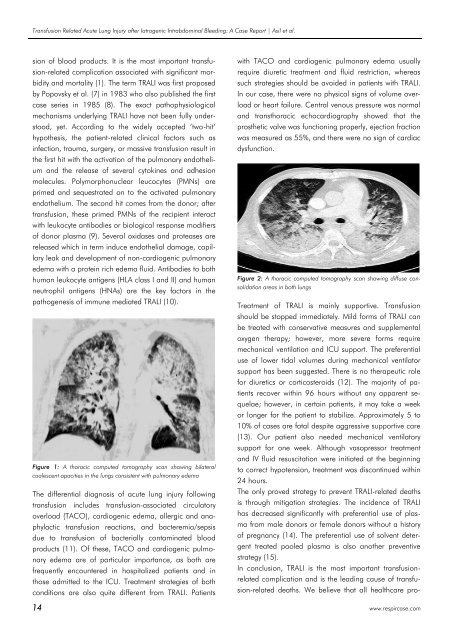Respircase Cilt: 6 - Sayı: 1 Yıl: 2017
You also want an ePaper? Increase the reach of your titles
YUMPU automatically turns print PDFs into web optimized ePapers that Google loves.
Transfusion Related Acute Lung Injury after Iatrogenic Intrabdominal Bleeding: A Case Report | Asil et al.<br />
sion of blood products. It is the most important transfusion-related<br />
complication associated with significant morbidity<br />
and mortality (1). The term TRALI was first proposed<br />
by Popovsky et al. (7) in 1983 who also published the first<br />
case series in 1985 (8). The exact pathophysiological<br />
mechanisms underlying TRALI have not been fully understood,<br />
yet. According to the widely accepted ‘two-hit’<br />
hypothesis, the patient-related clinical factors such as<br />
infection, trauma, surgery, or massive transfusion result in<br />
the first hit with the activation of the pulmonary endothelium<br />
and the release of several cytokines and adhesion<br />
molecules. Polymorphonuclear leucocytes (PMNs) are<br />
primed and sequestrated on to the activated pulmonary<br />
endothelium. The second hit comes from the donor; after<br />
transfusion, these primed PMNs of the recipient interact<br />
with leukocyte antibodies or biological response modifiers<br />
of donor plasma (9). Several oxidases and proteases are<br />
released which in term induce endothelial damage, capillary<br />
leak and development of non-cardiogenic pulmonary<br />
edema with a protein rich edema fluid. Antibodies to both<br />
human leukocyte antigens (HLA class I and II) and human<br />
neutrophil antigens (HNAs) are the key factors in the<br />
pathogenesis of immune mediated TRALI (10).<br />
Figure 1: A thoracic computed tomography scan showing bilateral<br />
coalescent opacities in the lungs consistent with pulmonary edema<br />
The differential diagnosis of acute lung injury following<br />
transfusion includes transfusion-associated circulatory<br />
overload (TACO), cardiogenic edema, allergic and anaphylactic<br />
transfusion reactions, and bacteremia/sepsis<br />
due to transfusion of bacterially contaminated blood<br />
products (11). Of these, TACO and cardiogenic pulmonary<br />
edema are of particular importance, as both are<br />
frequently encountered in hospitalized patients and in<br />
those admitted to the ICU. Treatment strategies of both<br />
conditions are also quite different from TRALI. Patients<br />
with TACO and cardiogenic pulmonary edema usually<br />
require diuretic treatment and fluid restriction, whereas<br />
such strategies should be avoided in patients with TRALI.<br />
In our case, there were no physical signs of volume overload<br />
or heart failure. Central venous pressure was normal<br />
and transthoracic echocardiography showed that the<br />
prosthetic valve was functioning properly, ejection fraction<br />
was measured as 55%, and there were no sign of cardiac<br />
dysfunction.<br />
Figure 2: A thoracic computed tomography scan showing diffuse consolidation<br />
areas in both lungs<br />
Treatment of TRALI is mainly supportive. Transfusion<br />
should be stopped immediately. Mild forms of TRALI can<br />
be treated with conservative measures and supplemental<br />
oxygen therapy; however, more severe forms require<br />
mechanical ventilation and ICU support. The preferential<br />
use of lower tidal volumes during mechanical ventilator<br />
support has been suggested. There is no therapeutic role<br />
for diuretics or corticosteroids (12). The majority of patients<br />
recover within 96 hours without any apparent sequelae;<br />
however, in certain patients, it may take a week<br />
or longer for the patient to stabilize. Approximately 5 to<br />
10% of cases are fatal despite aggressive supportive care<br />
(13). Our patient also needed mechanical ventilatory<br />
support for one week. Although vasopressor treatment<br />
and IV fluid resuscitation were initiated at the beginning<br />
to correct hypotension, treatment was discontinued within<br />
24 hours.<br />
The only proved strategy to prevent TRALI-related deaths<br />
is through mitigation strategies. The incidence of TRALI<br />
has decreased significantly with preferential use of plasma<br />
from male donors or female donors without a history<br />
of pregnancy (14). The preferential use of solvent detergent<br />
treated pooled plasma is also another preventive<br />
strategy (15).<br />
In conclusion, TRALI is the most important transfusionrelated<br />
complication and is the leading cause of transfusion-related<br />
deaths. We believe that all healthcare pro-<br />
14 www.respircase.com

















